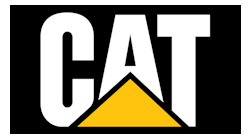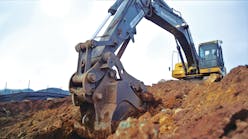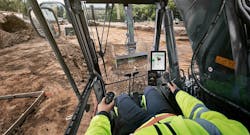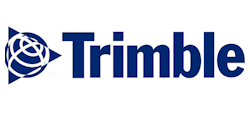It was merely a few years back, that when an individual was seen holding a cell phone, you could easily assume he was, quite simply, calling someone. Today, that individual might be hosting a Skype meeting, reading the news, or wiring money. When Smartphones first rolled out, it took a few years of us just scratching the surface of capability before we started customizing the experience with apps to meet individual needs. And although we’ve made significant progress, scratching the surface is exactly where Paul Kearnan, telematics expert at Strongco, says the construction industry is with telematics.
Today, Kearnan oversees roughly 3,500 telematics-equipped customer machines at Strongco—a Volvo Construction Equipment dealer with 27 locations across Canada and five in the northeastern United States, operating under the Chadwick-BaRoss name. As the number of Strongco customers using telematics (each to varying degrees) has grown significantly under his tenure—so, too, has his ability to recognize what makes some companies incredibly successful in telematics implementation, while others fail to fully reap the benefits.
According to Kearnan, successful implementation comes down to four factors: finding a dedicated champion for the technology, customizing the reporting to meet individual needs, involving all stakeholders in the plan development, and implementing an API for ease of integration.
1. Find a Champion
The year 2011 marked a tipping point for Strongco. The company recognized that before it could sell the value of telematics to customers, it had to first sell that value internally, to its sales team, and to its parts and maintenance teams. That’s when Strongco hired Kearnan to lead the charge.
“When I first started, telematics was still so new,” says Kearnan. “It wasn’t something people were paying a lot of attention to yet. And here in our office, everyone was incredibly busy—there wasn’t time for them to try and tackle what felt like a huge undertaking. It was good for me in a way, because it gave me an opportunity to build this project from the ground up.”
And that’s exactly where he started: on the inside. He created customized training programs for all divisions of Strongco staff, from the mechanics to the salespeople. It showed them how telematics could intersect with their roles specifically, what would be most important to them and how it would help them be more efficient or deliver a better product—from planning service schedules to having data at hand that customers can use to make more informed purchase decisions.
This predicament faced by Strongco in 2011—the predicament of recognizing that there is potential in telematics, but feeling too busy to tackle the planning and internal education to successfully implement it—is the same predicament faced by many construction companies today.
“The companies who are seeing great success are the ones who have recognized they can’t just ask a team member who is already working at 110% capacity to single-handedly undertake the implementation of telematics and expect it to be quickly successful companywide,” says Kearnan. “You really have two options if you want to see success: you can either enlist the help of a knowledgeable equipment dealer who can aid in developing a plan, offer training and provide remote monitoring services on your behalf, or you can assign an internal champion who has ample time to build a plan and generate excitement about it internally, much the way we did at Strongco in 2011.”
Paul Kearnan in Strongco’s telematics monitoring center
2. Customize the Experience
Success with telematics doesn’t necessarily mean using all of its bells and whistles, however. One size does not fit all when it comes to the way companies can benefit from its use.
“At Strongco, when we sell a machine to a customer, we aim to sell him exactly what he needs to get the job done most effectively, nothing more,” says Kearnan. “It’s the same thing with telematics. We shouldn’t be asking customers to bite off more than they can chew. The goal is to make it relevant, not overwhelming. Every customer is going to want something different from a telematics report; it’s about finding the right value for the particular customer.”
A perfect example of “simpler can be better” is Hub Equipment, a rental house served by Strongco with 85 telematics-equipped machines. Hub Equipment began using telematics in 2009, when the company was offered telematics factory-equipped as part of the machine purchase through OEMs.
The company hones in solely on location tracking and machine hours to help plan service. Joe Cuzzolino, rental operations manager at Hub Equipment says using basic telematics is a perfect fit for them, and it helps better service their machines and serve their customers.
“It takes me just five minutes to pull the reports from our Volvo equipment at the end of the day—it’s incredibly easy and it helps us plan for service in a way that least inhibits our customers. Back in the day, we used to just roll up to a job site and perform service. That’s not acceptable to our customers anymore. We can’t just come onsite; they have needs they’re trying to meet for their customers, too. So, tracking hours this way allows us to plan when we need to be looking at service, know where the machines are at, and allows more flexibility for our customers whose ultimate goal is obviously to keep the machine up, running, and moving on to the next site.”
Kearnan says when it comes to owner-operators, the value proposition lies much more in being able to help them easily access information about their machines.
“These guys are in their machines for 12- or 14-hour days, every day,” he explains. “Do they want to come home and pull reports? No. The great thing for them is that these reports can be set up to go directly to their inbox on a schedule they prefer. Easy-to-read charts that flag if there are any areas that should be looked at, and on they go. Even if a guy has 10 pieces of machinery, telematics makes sense. You can get your service plan schedule aligned with your work schedule. Say you’re on a 100-hour service plan, you’re needing service about every few weeks dependent upon application—now you can organize your job based on that downtime. It’s not the most extensive thing telematics can offer, but it’s the smaller things like that that are making a big difference to customers’ bottom lines over time.”
And then, there are the fleet managers. And when you even mention the group fleet manager, Kearnan starts talking faster. He’s excited.
Strongco’s service team and telematics team work hand in hand.
“The opportunities that exist for companies that employ a fleet manager are incredible,” says Kearnan. “When you have a champion on your customer team who understands the value of telematics, then you can start discussions that will allow for the most informed decision-making that’s ever taken place at a company. Owners and fleet managers can have complete management and insight into their machines, shaping everything from operator training and safety programs, down to the way the companyformulates competitive project bids with a complete record of machine productivity and the associated operating costs. Those financial implications can be immense.”
Kearnan notes, however, that to make the most of telematics, fleet managers, owners and dealers have to change the “old” communication model.
3. Involve All Stakeholders
“The most valuable change will come when we change the way we think about the ‘traditional’ model of communication and partnership between a dealer and a customer. The best case scenario for telematics is that a telematics point person at a dealership is working in conjunction with both a fleet manager and an owner to build and track a telematics program.”
Kearnan recognizes that fleet managers have so much on their plates, dealers often have to be a partner in telematics. But, he says it’s vital that all three parties are in communication so that everyone is getting the most out of the partnership.
“Fleet managers and owners have different roles at their business for a reason,” he adds. “Our customer support staff can work with them to ensure the telematics program we build gives them both the information that they need to make strong decisions. That said, though, we have to shift the communication model. There have been multiple times we’ve made a recommendation and it seems to get lost in the shuffle. Big companies have a lot more people at the decision-making table, and it’s vital to get all of those parties on the same page in regard to their telematics program in order to get the most from it. We’ll see opportunities, for instance, where it makes sense for a customer to swap two smaller class machines for one larger machine—they won’t lose on productivity and they’ll gain on fuel efficiency. That’s a decision that needs to be made by the fleet manager, and likely an owner or an executive.”
Don’t forget the operators: With bigger operations and bigger fleets, it can be easy to become distanced from your operators. However, telematics data offers an excellent opportunity to monitor operator behavior and improve training. It gives fleet managers fantastic insights about how they may see productivity differences in certain operators, fuel efficiency gains in certain operators, and begin to communicate changes with the operator and provide training that can lead to long-term benefits. And, there are some smaller things, too.
“A while back, a customer called me and said his machine report showed that the machine started up at 8:00 a.m., turned off 10 minutes later, and didn’t start up again until 9:30. ‘What’s that about?’ he asked. We checked break time off the list—that wasn’t until 10 in the morning. So then I said, ‘You can ask your operator. It could have been many things. Maybe a truck delivery came, maybe there was a breakdown,’ maybe this or that, but these reports give complete management to the owner into even the tiniest details if they want to take it that far. These things happen a lot, and when it’s done well, it builds communication between the owners and operators.”
4. Implement an API
One of the reasons many people have been slow to adopt telematics as a larger scale program beyond just machine hours and location tracking is due to the fact that multiple manufacturers offer telematics systems, so naturally the question becomes—what do I do if I have a mixed fleet? What may already feel daunting can become a complete nightmare when you imagine running five different reports with five different platforms created by five different manufacturers, then comparing side-by-side just to get a good picture of what’s happening with your fleet.
This wasn’t a small concern for the industry. In fact, addressing it required a lot of people at the table. The force most equipped to tackle the issue was the Association of Equipment Management Professionals (AEMP). AEMP recognized it was going to be an industry wide challenge that would require extensive collaboration and compromise. AEMP drove the initiative forward, and in September 2014 proudly announced the launch of the Application Programming Interface, or API. The program provides customers with mixed fleets the ability to conveniently access 19 data fields across the fleet—regardless of brand.
But just as with telematics, driving adoption of the API will require multiple champions, and Strongco will once again need to lead by example with its customers.
“Of the roughly 3,500 customer machines being monitored by telematics—many of them are operating in mixed fleets—but off the top of my head, I can only think of one customer currently using the API. That’s why we at Strongco are now implementing the API in our telematics control center that we’re building—to be better able to train our customers on its use. Ultimately, it’s going to drive adoption of telematics, which will make everyone’s lives easier—from the OEM to the dealer to the customer.”
It’s this triangle relationship, according to Kearnan, that is key to progress.
The progress ahead: “I have the luxury of sitting in this seat where I see what’s ahead. I see so much opportunity for us. Predictive maintenance is going to add a ton of value for our customers. Right now, it’s just on us to phase customers in to telematics in a way that doesn’t overwhelm them, but helps them see how it can make their lives easier. Without a doubt, it’s our role to bridge that gap between OEM and end user—and the way we do that is a little different for each of our customers.”
Despite there being many more guidelines to success than there were five years ago, there’s still a long way to go, according to Kearnan, and communication is key to furthering the roadmap.
“As we continue to build more customized programs for our customers, we’re reporting back up to the manufacturers, and they’re using that feedback to further research and develop their technologies. Simultaneously, some of the manufacturers we’re working with are starting to arm us with more program options, such as dealer-managed and even OEM-managed telematics monitoring and reporting services that ease that adoption process for curious customers who don’t know where to begin.”
As for the future of telematics, Kearnan doesn’t want to overwhelm anyone by speculating about the minutia. Rather, he puts it as simply as he does when trying to ease a customer into telematics in the first place.
“I think it’s going to be a great thing,” he says. “I’m pretty excited about it to tell you the truth.”
And with good reason.












